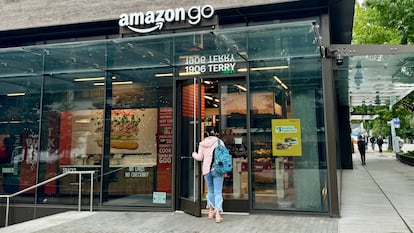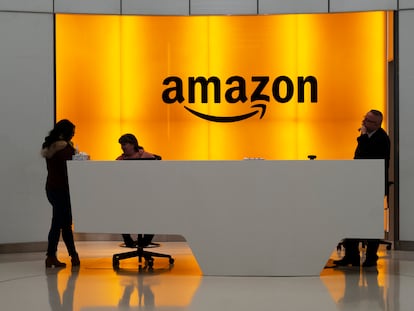Amazon used an algorithm to essentially raise prices on other sites, the FTC says
The FTC said Amazon ‘destroyed more than two years’ worth of communications from June 2019 to ‘at least early 2022′despite instructions it gave Amazon not to do so

Amazon used a secret algorithm that essentially helped the company raise prices on other online sites and “destroyed” some internal communications as the Federal Trade Commission was investigating the company, according to newly unredacted portions of the agency’s antitrust lawsuit against the e-commerce giant.
The new excerpts unveiled Thursday allege Amazon executives intentionally deleted communication by using a feature on the popular app Signal that makes messages disappear. By doing this, the FTC said Amazon “destroyed more than two years” worth of communications from June 2019 to “at least early 2022″ despite instructions it gave Amazon not to do so.
In a prepared statement Amazon spokesperson Tim Doyle called the FTC’s claim “baseless and irresponsible.” “Amazon voluntarily disclosed employee Signal use to the FTC, painstakingly collected Signal conversations from its employees’ phones, and allowed agency staff to inspect those conversations even when they had nothing to do with the FTC’s investigation,” Doyle said.
The FTC and 17 states sued Amazon in September alleging the company was abusing its position in the marketplace to inflate prices on and off its platform, overcharge sellers and stifle competition. Amazon is accused of violating federal and state antitrust laws, but the company has responded with a full-throated defense of its business practices.
The antitrust case is the most aggressive move the government has taken to tame the market power of Seattle-based Amazon and comes as the FTC has been taking big swings against tech companies.
The unredacted excerpts of the lawsuit disclosed on Thursday also provided more details on a talked-about algorithm, which was previously reported by The Wall Street Journal and former Vox reporter Jason Del Ray.
The FTC’s excerpts say the tool — codenamed “Project Nessie” — has been used by Amazon to pinpoint products that will allow it to rake in more cash. The company used it to predict where it can raise prices and have other shopping sites follow suit. Amazon activated the algorithm to raise prices on some products, and when other sites followed its lead, it kept the elevated prices in place, the agency said. The use of Nessie has generated more than $1 billion in excess profits for Amazon, according to the FTC.
“Aware of the public fallout it risks, Amazon has turned Project Nessie off during periods of heightened outside scrutiny and then back on when it thinks that no one is watching,” the complaint said.
The agency said Amazon deployed Project Nessie in 2014 and has turned it on and off at least eight times between 2015 and 2019. In 2018 alone, Amazon used the algorithm to set prices for items that were viewed more than 400 million times by shoppers, according to the complaint.
Regulators said though Amazon claims the algorithm is “currently paused,” the company has thought about running experiments in 2020 and 2021 to improve the effectiveness of Project Nessie. Doyle, the Amazon spokesperson, called Nessie an “old” pricing algorithm that’s being “grossly” mischaracterized by the agency.
“Nessie was used to try to stop our price matching from resulting in unusual outcomes where prices became so low that they were unsustainable,” he said. “The project ran for a few years on a subset of products, but didn’t work as intended, so we scrapped it several years ago.”
Among other things, the unredacted portions of the lawsuit also shed more light on Amazon’s advertising business. The agency claimed then-CEO Jeff Bezos instructed executives to accept more junk ads — internally called “defects” — because the company could earn more money through increased advertising despite their presence being a headache for consumers. In response, Doyle said Amazon “works hard to make it fast and easy” for customers to find items and discover other options “by providing a mix of organic and sponsored search results” based on factors such as relevance, reviews, availability, price and speed of delivery.
Another unredacted portion of the lawsuit provided more details on the government’s allegations that Amazon is essentially compelling sellers to use its logistics service called Fulfillment by Amazon, or FBA. One example is an Amazon program called Seller Fulfilled Prime, which allowed third-party sellers to display a Prime badge on their listings without using FBA. Sellers want the Prime badge because it indicates fast shipping and can lead to higher sales.
The agency said in early 2019, the company turned against the program when it learned other fulfillment providers were advertising their services to sellers. Amazon suspended enrollment in the program a few years ago, saying it wasn’t delivering the same high-quality experience customers expect from Prime. But the agency said in 2018, sellers enrolled in the program had met a “delivery estimate” requirement set by Amazon more than 95% of the time.
The lawsuit also cited an email from an Amazon executive, who wrote he was “losing (his) mind” after learning UPS was advertising it could fulfill Prime-eligible orders. Two “high-level” Amazon executives agreed in the same email chain that the company should consider shutting down Seller Fulfilled Prime in the U.S., the FTC said.
NetChoice, an industry group backed by Amazon, said Thursday the FTC was being misleading and the delivery estimates noted in the complaint were set by sellers, not Amazon. Doyle, of Amazon, also said in 2018, sellers using the program were “promising deliveries within two days less than 16% of the time—far worse than the performance of sellers using Fulfillment by Amazon.” The company reopened enrollment into the program a few months ago.
Sign up for our weekly newsletter to get more English-language news coverage from EL PAÍS USA Edition
Tu suscripción se está usando en otro dispositivo
¿Quieres añadir otro usuario a tu suscripción?
Si continúas leyendo en este dispositivo, no se podrá leer en el otro.
FlechaTu suscripción se está usando en otro dispositivo y solo puedes acceder a EL PAÍS desde un dispositivo a la vez.
Si quieres compartir tu cuenta, cambia tu suscripción a la modalidad Premium, así podrás añadir otro usuario. Cada uno accederá con su propia cuenta de email, lo que os permitirá personalizar vuestra experiencia en EL PAÍS.
¿Tienes una suscripción de empresa? Accede aquí para contratar más cuentas.
En el caso de no saber quién está usando tu cuenta, te recomendamos cambiar tu contraseña aquí.
Si decides continuar compartiendo tu cuenta, este mensaje se mostrará en tu dispositivo y en el de la otra persona que está usando tu cuenta de forma indefinida, afectando a tu experiencia de lectura. Puedes consultar aquí los términos y condiciones de la suscripción digital.
More information
Archived In
Últimas noticias
Christmas loses its festive spirit: ICE fears cast shadow over religious celebrations
All the effects of gentrification in one corner of Mexico’s Colonia Roma
Palestinian reporter Youmna El Sayed: ‘My family told me I had to choose between being a journalist or a mother’
The new language of the workplace: Knowing how to ask AI questions is more important than using it
Most viewed
- The low-cost creative revolution: How technology is making art accessible to everyone
- Christian Louboutin: ‘Young people don’t want to be like their parents. And if their parents wear sneakers, they’re going to look for something else’
- US sanctions against jailed cartel leader ‘El Marro’ highlight Mexico’s lack of control over its prisons
- Liset Menéndez de la Prida, neuroscientist: ‘It’s not normal to constantly seek pleasure; it’s important to be bored, to be calm’
- Cartels in Mexico take a leap forward with narco-drones: ‘It is criminal groups that are leading the innovation race’









































